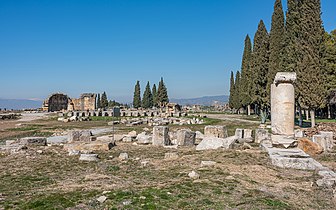Agora
This article needs additional citations for verification. (December 2021) |

The agora (/ˈæɡərə/; Ancient Greek: ἀγορά, romanized: agorá, meaning "market" in Modern Greek) was a central public space in ancient Greek city-states. It is the best representation of a city-state's response to accommodate the social and political order of the polis.[1] The literal meaning of the word "agora" is "gathering place" or "assembly". The agora was the center of the athletic, artistic, business, social, spiritual, and political life in the city.[2] The Ancient Agora of Athens is the best-known example.
Origins[edit]
Early in Greek history (10th–4th centuries BC), free-born citizens would gather in the agora for military duty or to hear statements of the ruling king or council. Later, the agora also served as a marketplace, where merchants kept stalls or shops to sell their goods amid arcades. This attracted artisans who built workshops nearby.[3][better source needed]
From these twin functions of the agora as a political and a commercial spot came the two Greek verbs ἀγοράζω, agorázō, "I shop", and ἀγορεύω, agoreúō, "I speak in public".[4]
Ancient Agora of Athens[edit]

The Ancient Agora of Athens was situated beneath the northern slope of the Acropolis. The Ancient Agora was the primary meeting ground for Athenians, where members of democracy congregated affairs of the state, where business was conducted, a place to hang out, and watch performers and listen to famous philosophers. The importance of the Athenian agora revolved around religion. The agora was a very sacred place, in which holiness is laid out in the architecture of the ground upon which it lay. The layout of the agora was centered around the Panathenaic Way, a road that ran through the middle of Athens and to the main gate of the city, Dipylon.[5] This road was considered tremendously sacred, serving as a travel route for the Panathenaic festival, which was held in honor of the goddess Athena every four years. The agora was also famously known for housing the Temple of Hephaestus, the Greek god of metalworking and craftsmen. This temple is still in great condition to this day. Other temples priorly standing in the agora include honor for Zeus, Athena, Apollo, and Ares.[6]
Location and constituents[edit]

The agora was usually located in the middle of a city or near the harbor. Agoras were built of colonnades, or rows of long columns, and contained stoae, also known as a long open walkway below the colonnades.[7] They were beautifully decorated with fountains, trees, and statues. When the Athenian agora was rebuilt after the Greco-Persian Wars, colonnades and stoae were not incorporated.[8]
Phobia[edit]
The term agoraphobia denotes a phobic condition in which the sufferer becomes anxious in unfamiliar environments – for instance, places where they perceive that they have little control. Such anxiety may be triggered by wide-open spaces, crowds, or public situations, and the psychological term derives from the agora as a large and open gathering place.
Gallery[edit]
-
The Side State Agora in Side, Turkey
-
The Agora of Ephesus
-
Tlos Agora, southern Turkey
-
The Agora of the Competaliasts on Delos, Greece
-
Remains of the Roman Agora built in Athens during the Roman period
-
The Agora of Hierapolis, Turkey
-
The Roman Agora (Delphi), Greece
-
South agora and pool in Aphrodisias, Turkey
See also[edit]
References[edit]
- ^ Caves, R. W. (2004). Encyclopedia of the City. Routledge. p. 10.
- ^ Ring, Trudy; Salkin, Robert; Boda, Sharon (1996). International Dictionary of Historic Places: Southern Europe. Routledge. p. 66. ISBN 978-1-884964-02-2.
- ^ Peppas, Lynn (2005). Life in Ancient Greece. Crabtree Publishing Company. p. 12. ISBN 0778720357. Retrieved 6 January 2017.
- ^ ἀγορά, ἀγοράζω, ἀγορεύω. Liddell, Henry George; Scott, Robert; A Greek–English Lexicon at the Perseus Project.
- ^ "The Archaic Athenian Agora: Gateway to Classical Athenian Democracy". World History Encyclopedia. Retrieved 2020-12-01.
- ^ "The Athenian Agora". Atlas Obscura. Retrieved 2020-10-03.
- ^ "Stoa | architecture". Encyclopedia Britannica. Retrieved 2020-12-01.
- ^ "agora | Definition, History, & Facts". Encyclopedia Britannica. Retrieved 2020-12-01.
External links[edit]
 Media related to Agoras at Wikimedia Commons
Media related to Agoras at Wikimedia Commons- Official Athenian agora excavations
- Agora in Athens: photos








